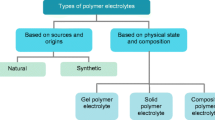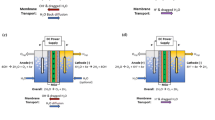Abstract
Proton conducting polymer electrolytes bearing phosphonic acid units are very promising due to their high conductivity, thermal and chemical stability. In the present work, proton conducting nanocomposite electrolytes containing poly(vinylphosphonic acid) (PVPA) and SiO2 were prepared by two different methods. The interaction existed between PVPA and SiO2 was confirmed by FT-IR spectroscopy. The surface roughness of the nanocomposites was studied using AFM. Thermogravimetric analysis revealed that the samples were thermally stable up to 200 °C. The glass transition temperature (Tg) of the materials were determined using DSC. In the anhydrous state, the proton conductivity of PVPA(10)SiO2 (in situ) was found to be 0,009 (Scm−1) at 120 °C. The proton conductivity of PVPA(10)SiO2 increased to 0.08 (Scm−1) at 50 % relative humidity. The SiO2 nanoparticles in the composite membranes improved the thermal properties and increased the proton conductivity.











Similar content being viewed by others
References
Acar O, Sen U, Bozkurt A, Ata A (2009) Proton conducting membranes based on Poly(2,5-benzimidazole) (ABPBI)–Poly(vinylphosphonic acid) blends for fuel cells. Int J Hydrogen Energy 34:2724–2730
Bozkurt A, Meyer WH, Gutmann J, Wegner G (2003) Proton conducting copolymers on the basis of vinylphosphonic acid and 4-vinylimidazole. Solid State Ionics 164:169–176
Bruce PG (ed) (1995) Solid state electrochemistry. Cambridge University Press, Cambridge
Gray FM (1997) Polymer electrolytes. Royal Society of Chemistry Monographs, Cambridge
Hagihara H, Uchida H, Watanabe M (2006) Preparation of highly dispersed SiO2 and Pt particles in Nafion®112 for self-humidifying electrolyte membranes in fuel cells. Electrochim Acta 51:3979–3985
Bao C, Ouyang MG, Yi BL (2006) Analysis of the water and thermal management in proton exchange membrane fuel cell systems. Int J Hydrogen Energy 31:1040–1057
Savadogo O (2004) Emerging membranes for electrochemical systems: part II. High temperature composite membranes for polymer electrolyte fuel cell (PEFC) applications. J Power Sources 127:135–161
Hickner MA, Ghassemi H, Kim YS, Einsla BR, McGrath JE (2004) Alternative polymer systems for proton exchange membranes (PEMs). Chem Rev 104:4587–4612
Souzy R, Ameduri B (2005) Functional fluoropolymers for fuel cell membranes rog. Polym Sci 30:644–687
Sevil F, Bozkut A (2004) Proton conducting polymer electrolytes on the basis of poly(vinylphosphonic acid) and imidazole. J Phys Chem Solids 65:1659–1662
Yang H, Srinivasan S, Bocarsly AB, Tulyani S, Benziger JB (2004) A comparison of physical properties and fuel cell performance of Nafion and zirconium phosphate/Nafion composite membranes. J Memb Sci 237:145–161
Weston JK, Steele BCH (1982) Effects of inert fillers on the mechanical and electrochemical properties of lithium salt-poly(ethylene oxide) polymer electrolytes. Solid State Ionics 7:75–79
Moskwiak M, Giska I, Borkowska R, Zalewska A, Marczewski M, Marczewska H, Wieczorek W (2006) Physico- and electrochemistry of composite electrolytes based on PEODME–LiTFSI with TiO2. Power Sources 159:443–446
Croce F, Appetecchi GB, Persi L, Scrosati B (1998) Nanocomposite polymer electrolytes for lithium batterie. Nature 394:456–458
Kumar B (2007) In: Khare N, Hashmi SA, Chandra A, Chandra A (eds) Electroactive polymers: materials and devices, vol I. Allied publishers, New Delhi, p 53
Macarie L, Ilia G (2010) Poly(vinylphosphonic acid) and its derivatives. Prog Polym Sci 35:1078–1092
Pandey GP, Hashmi SA, Agrawal RC (2008) Hot-press synthesized polyethylene oxide based proton conducting nanocomposite polymer electrolyte dispersed with SiO2 nanoparticles. Solid State Ionics 179:543–549
Pu H, Pan H, Qin Y, Wan D, Yuanu J (2010) Phosphonic acid-functionalized hollow silica spheres by nitroxide mediated polymerization. Mater Lett 64:1510–1512
Aslan A, Bozkurt A (2009) Development and characterization of polymer electrolyte membranes based on ionical cross-linked poly(1-vinyl-1,2,4 triazole) and poly(vinylphosphonic acid). J Power Sources 191:442–447
Aslan A, Bozkurt A (2011) Proton conducting properties of ionically cross-linked poly(1-vinyl-1,2,4 triazole) and poly(2-acrylamido- 2-methyl-1-propanesulfonic acid) electrolytes. Polym Bull 66:1099–1111
Çelik SU, Akbey U, Graf R, Bozkurt A, Spiess HW (2008) Anhydrous proton-conducting properties of triazole–phosphonic acidcopolymers: a combined study with MAS NMR. Phys Chem Chem Phys 10:6058–6066
Percy MJ, Barthet C, Lobb JC, Khan MA, Lascelles SF, Vamvakaki M, Armes SP (2000) Synthesis and characterization of Vinyl Polymer-Silica colloidal nanocomposites. Langmuir 16:6913–6920
Lee YJ, Bingöl B, Murakhtina T, Sebastiani D, Meyer WH, Wegner G, Spiess HW (2007) High resolution solid state NMR studies of Poly(vinyl phosphonic acid) proton conducting polymer: molecular structure and proton dynamics. J Phys Chem B 111:9711–9721
Sedin DL, Rowlen KL (2001) Influence of tip size on AFM roughness measurements. Appl Surf Sci 182:40–48
Goktepe F, Çelik SU, Bozkurt A (2008) Preparation and the proton conductivity of chitosan/poly(vinyl phosphonic acid) complex polymer electrolytes. J Non-Cryst Solids 354:3637
Ou DL, Seddon AB (1997) Near- and mid-infrared spectroscopy of sol–gel derived ormosils: vinyl and phenyl silicates. J Non-Cryst Solids 210:187–203
Parler CM, Ritter JA, Amiridis MD (2001) Infrared spectroscopic study of sol–gel derived mixed-metal oxides. J Non-Cryst Solids 279:119–125
Cho SA, Cho EA, Oh IH, Kim HJ, Ha HY, Hong SA, Ju JB (2006) Surface modified Nafion membrane by ion beam bombardment for fuel cell applications. J Power Sources 155:286–290
Wagner T, Manhart A, Deniz N, Kaltbeitzel A, Wagner M, Brunklaus G, Meyer WH (2009) Vinylphosphonic acid homo- and block copolymers Macromol. Chem Phys 210:1903–1914
Chuang S-W, Hsu SL-C, Liu Y-H (2007) J Membr Sci 305:353–363
Munakata H, Chiba H, Kanamura K (2005) Solid State Ionics 176:2445
Gasa JV, Boob S, Weiss RA, Shaw MT (2006) J Membr Sci 269:177
Mehtap SB, Sevim UC, Ayhan B, Ismail B (2011) J Membr Sci 375:157–164
Lin J, Wycisk R, Pintauro PN, Kellner M (2007) Electrochem Solid State Lett 10:B19
Lin J, Wu P-H, Wycisk R, Trivisonno A, Pintauro PN (2008) J Power Sources 183:491
Kaltbeitzel A, Schauff S, Steininger H, Bingöl B, Brunklaus G, Meyer WH, Spiess HW (2007) Water sorption of poly(vinylphosphonic acid) and its influence on proton conductivity. Solid State Ionics 178:469
Takimoto N, Wu L, Ohira A, Takeoka Y, Rikukawa M (2009) Hydration behavior of perfluorinated and hydrocarbon-type proton exchange membranes: relationship between morphology and proton conduction. Polymer 50:534–540
Casciola M, Alberti G, Sganappa M, Narducci R (2006) On the decay of Nafion proton conductivity at high temperature and relative humidity. J Power Sources 162:141–145
Acknowledgments
This work was supported by Fatih University Research Foundation under the contract number P50021005_G and partially supported by TÜBA.
Author information
Authors and Affiliations
Corresponding author
Rights and permissions
About this article
Cite this article
Aslan, A., Gölcük, K. & Bozkurt, A. Nanocomposite polymer electrolytes membranes based on Poly(vinylphosphonic acid)/SiO2 . J Polym Res 19, 22 (2012). https://doi.org/10.1007/s10965-012-0022-3
Received:
Accepted:
Published:
DOI: https://doi.org/10.1007/s10965-012-0022-3




